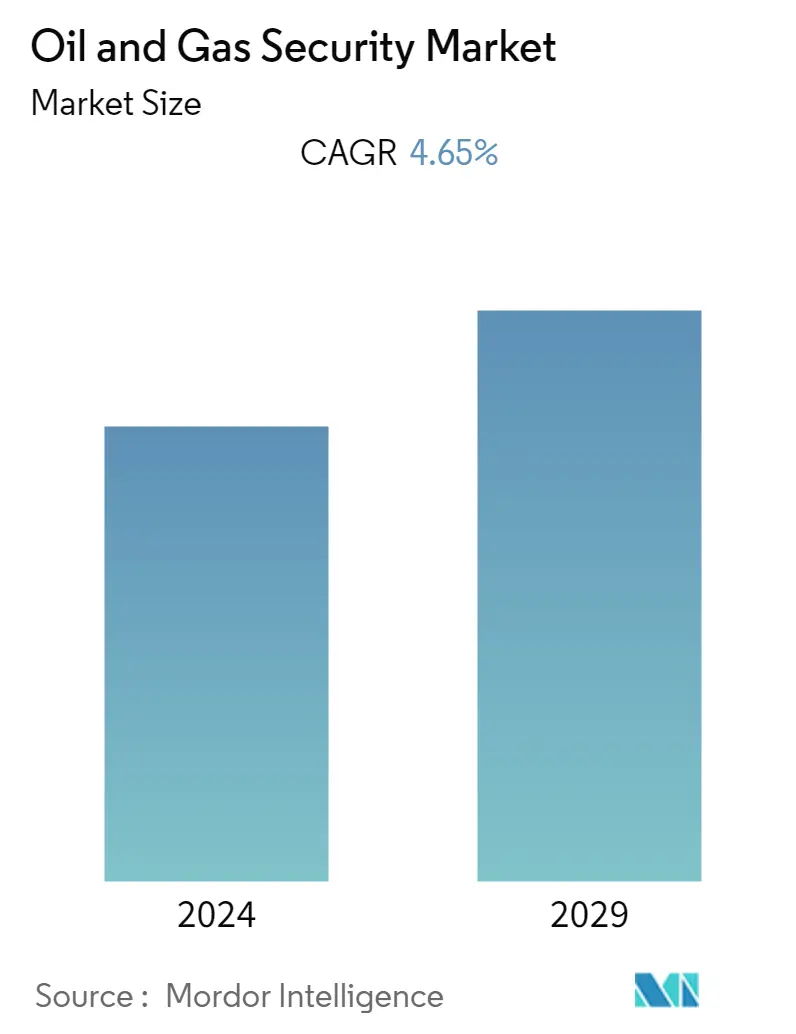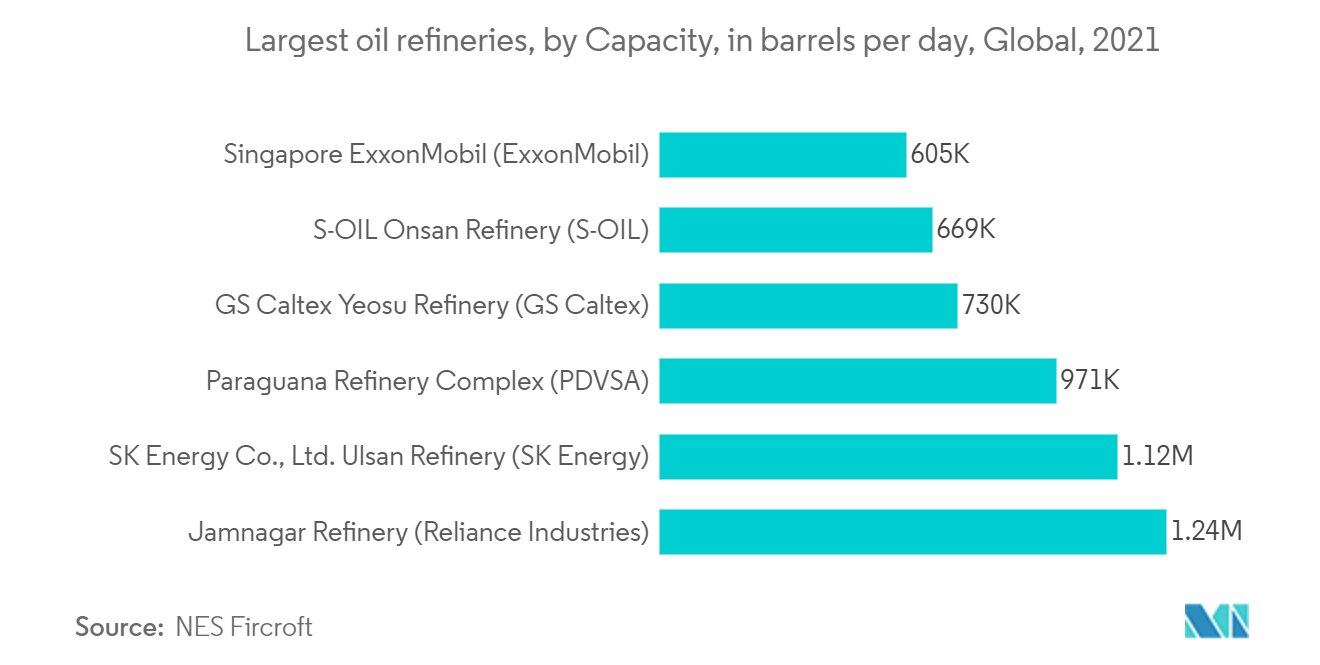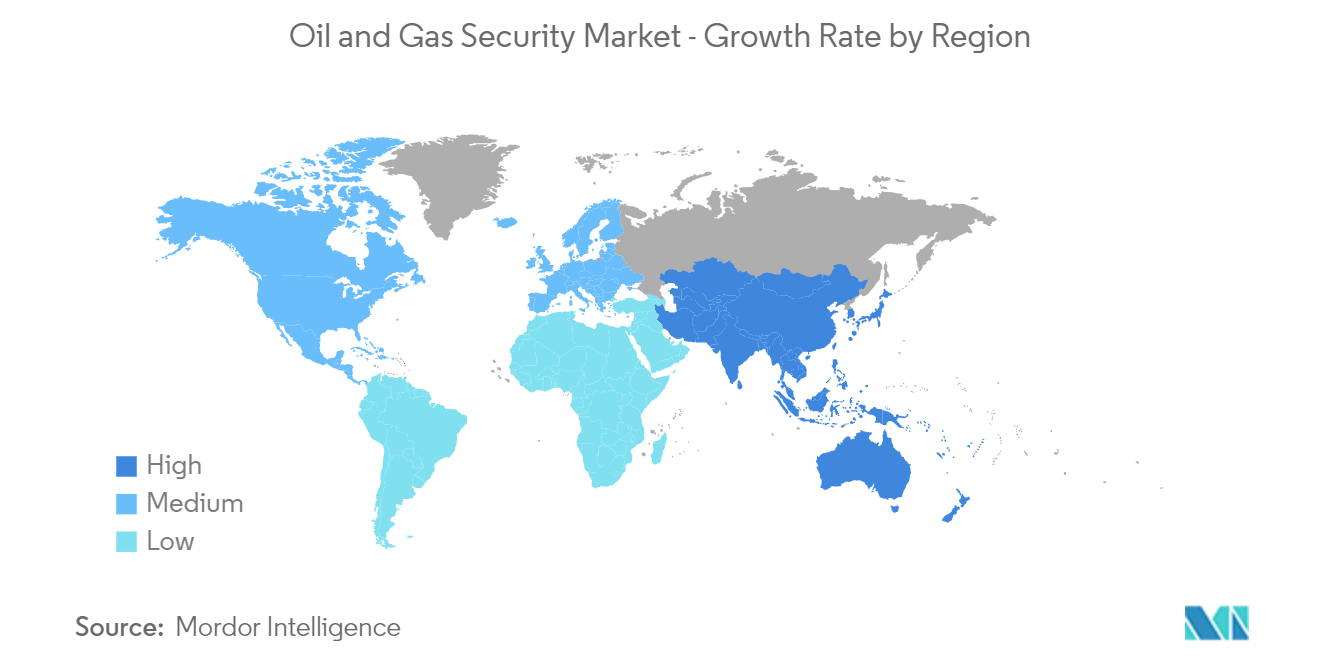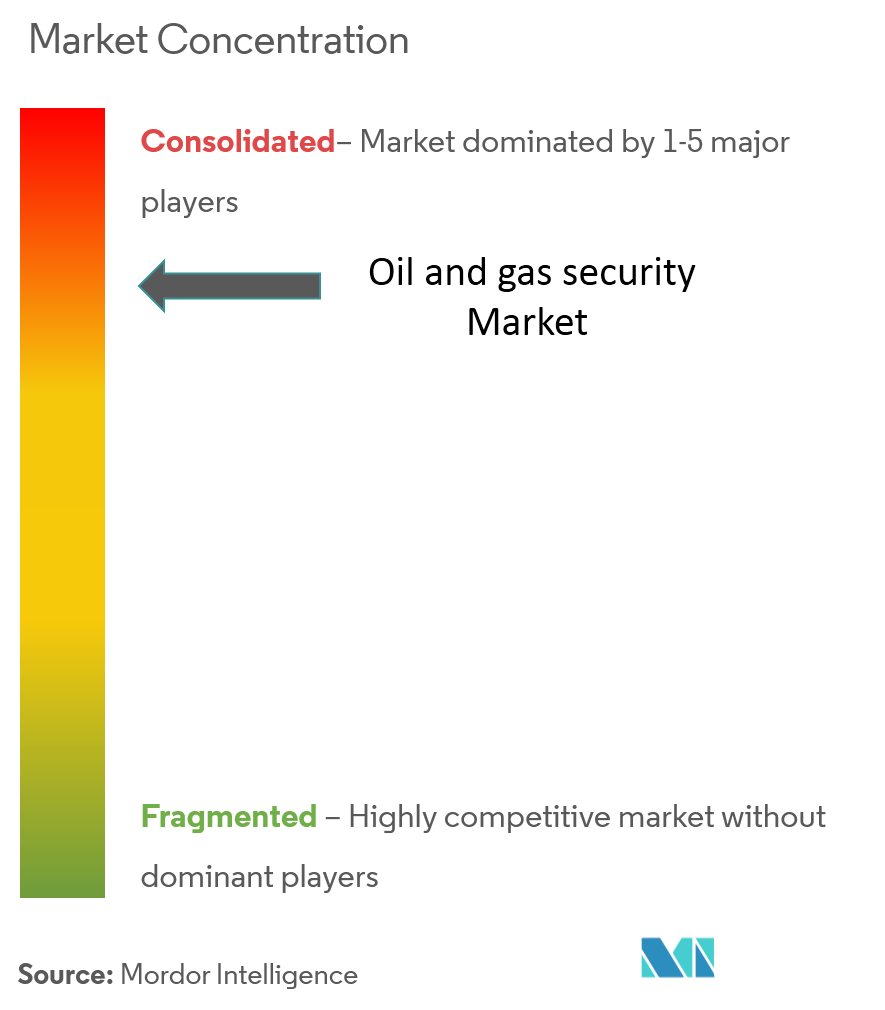Oil & Gas Security Market Size

| Study Period | 2019 - 2029 |
| Base Year For Estimation | 2023 |
| CAGR | 4.65 % |
| Fastest Growing Market | Asia Pacific |
| Largest Market | North America |
| Market Concentration | High |
Major Players
*Disclaimer: Major Players sorted in no particular order |
Oil & Gas Security Market Analysis
The Oil and Gas Security market is expected to grow at a CAGR of 4.65% over the forecast period. The growth in the digitization of the oil and gas industry has made it prone to cyber-attacks, such as denial of service, malware, and phishing. Moreover, cyber-attacks in the sector have caused significant disruptions to the entire network, including upstream, midstream, and downstream processes.
- Cyber-attacks, such as insider misuse, web application attacks, and physical risk/loss of property, have affected the oil and gas industry. Therefore, several companies are implementing effective cybersecurity solutions to combat them.
- An increase in the expenditure by oil and gas companies on network and operational technology security and an increased trend of security and vulnerability management have bolstered the growth of the oil and gas security market. Moreover, the growing trend of bringing your device (BYOD) into the industry poses further challenges for the security infrastructure.
- The rising energy demand and depletion of energy resources in recent years have put pressure on companies and governments to develop plans for oil and gas security system measures.
- Adopting new technology has significantly improved efficiency and brought concerns for securing these critical infrastructures essential for building a nation. The pipeline networks of the oil and gas industry extend to a vast area, and it is not economically viable in the current competitive market to use human resources to safeguard it. It has driven the economic surveillance system's demand and created opportunities for the players. Additionally, the products and machinery components installed within the core industry must adhere to flame and explosion-proof standards.
- Securing the resources is a paramount necessity through the totality of the product lifecycle, i.e., from the exploration, upstream, and downstream processes to the final product marketing. It is essential as they are dangerous to handle and prone to fire and other accidents. Web-based mobile surveillance units in such scenarios enable remote surveillance from a centralized or designated location and help streamline security. Aging infrastructure pushes the need for leadership for safety reasons.
- Owing to the operation ease brought about by network-driven communication in the industry, the security features are expected to be agile as network-driven communication systems also bring in vulnerability. Harsh weather conditions, extreme operating temperatures, hazardous processes, etc., make the market challenging. It requires compliance with multiple industry and safety standards for the products used in the industry and impacts the market landscape. All these factors have been critical for the demand and are expected to drive it over the forecast period.
- For oil, gas, and chemical businesses, the impact of COVID-19 and the oil price war is proving to be a two-pronged problem. Oil prices are falling due to failed production-cut agreements, and demand for chemicals and refined goods is slowing due to industrial slowdowns and travel restrictions in the aftermath of the global pandemic. Oil and Gas security is maintained by stringent physical and network security measures to ensure operational efficiency and minimize losses associated with security breaches. The shortfall of workers and expert security management personnel, mostly due to travel restrictions, illness, and social distancing norms, presents the Oil and Gas companies with another challenge in securing their Oil supplies and assets.
Oil & Gas Security Market Trends
This section covers the major market trends shaping the Oil & Gas Security Market according to our research experts:
Rise in the Level of Sophisticated Cyber-attacks to Drive the Market
- The growth in the digitization of the oil and gas industry has made it prone to cyber-attacks such as denial of service, malware, and phishing. Moreover, cyber-attacks in the sector have caused significant disruptions to the entire network, including upstream, midstream, and downstream processes. Various cyber-attacks, such as insider misuse, web application attacks, and physical risk/loss of property, have affected the oil and gas industry. Therefore, several companies are implementing effective cybersecurity solutions to combat them.
- However, a lack of awareness about oil and gas security solutions, difficulties in implementation for complicated operational technology, and the vulnerabilities associated with cloud technologies can challenge the growth of the oil and gas security market.
- An increase in the expenditure by oil and gas companies on network and operational technology security and an increased trend of security and vulnerability management have bolstered the growth of the oil and gas security market. Moreover, the growing trend of bringing your device (BYOD) into the industry poses further challenges for the security infrastructure. Thus, cyber security must be considered a priority in the industry.
- One of the primary reasons driving market expansion is the increasing digitization of the oil and gas industry. Data and sensitive information have been exposed to hacking and cyberattacks due to digital workflow processing, which is otherwise critical to guaranteeing smooth operations. As a result, governments worldwide are putting in place severe procedures to identify and mitigate cybersecurity vulnerabilities in the oil and gas industry, contributing considerably to market growth.
- Furthermore, this industry's distribution network typically spans thousands of acres, making it difficult to oversee using human resources. In such instances, oil and gas security measures, such as web-based mobile monitoring, become critical to ensuring effective network security and optimizing the overall security system. Other reasons, such as increased energy consumption, rapid depletion of energy supplies, and strong attempts by private and public entities to upgrade outdated infrastructure, are likely to push the industry further. Further digitalization, there will be a need for security systems to prevent data breaches, patent and business information, malware, and all other kinds of cyber threats.

North America Account for Largest Market Share
- The oil and gas production companies in North America, especially in the United States, are among the most efficient production companies in the world. As companies operating in the region move to address their specific security concerns, they are looking for holistic frameworks to help them implement prescriptive process changes.
- Exploration, production, processing, and delivery of products require enterprises to work with many external partners and third parties: these interactions and the need for electronic data interchange between various organizations. The stakeholders push to develop and implement security solutions to prevent potential cyber-attacks.
- For instance, Apache Corporation, a Houston-based oil and gas company with around three billion barrels' equivalent of oil and natural gas reserves, uses Microsoft's customized and modified security framework that considers everything from physical to logical access to application security to data protection to data continuity needed in the industry.
- The energy situation in North America is changing dramatically. The discovery of abundant tight oil and unconventional natural gas resources presents a once-in-a-generation chance to boost North American economic growth and increase the region's competitiveness in global markets. However, although this rapid change of physical infrastructure is well underway, the equally vital digital infrastructure and digital security need to catch up. Therefore, the decision-makers in government and industry aim for a safe, smart, and efficient path forward to utilize these resources.
- Malicious hacking from domestic or foreign enemies remains a constant threat to the United States. Time and now, the US reports on malicious malware attacks from foreign countries on US national assets such as Power Grids, Data Centers, Nuclear Power Plants, Military and Airforce bases, Communication networks, Banks, and others. On account, the US will spend around USD 9.8 billion on its civilian cybersecurity programs. Under these circumstances, US Oil and Gas firms face an absolute threat from cyber attacks, therefore forcing the firms to opt for the strongest cyber security tools and systems. This boosts the Oil and Security Market of the USA.

Oil & Gas Security Industry Overview
The Oil and gas security Market is highly concentrated due to the high initial investments and few buyers of the services. Some of the key players in the market are Cisco, ABB, and Microsoft. Some recent development in the market includes that in January 2023, oil and gas operators now have access to digital technologies through a recently formed cooperation between Siemens Energy and Amazon Web Service (AWS). This technology may be used to manage, monitor, and troubleshoot physical assets. In order to give customers a worldwide reach and powerful analytical capabilities over running assets, Siemens Energy and Amazon Web Services have partnered to provide Managed Detection and Response (MDR) technology.
Oil & Gas Security Market Leaders
-
Microsoft Corporation
-
ABB Ltd.
-
Cisco Systems Inc.
-
Honeywell International Inc.
-
Schneider Electric SE
*Disclaimer: Major Players sorted in no particular order

Oil & Gas Security Market News
- September 2022: ABB introduced ABB Ability Cyber Security Workplace (CSWP), which combines ABB and third-party security solutions into a single, all-inclusive digital platform to improve the security of the key industrial infrastructure. Engineers and operators may identify and address problems more quickly, lowering exposure to risk by making cybersecurity information more manageable and accessible.
- April 2022: Oil India, the victim of a cyberattack that cut off its activities in Assam, received a ransom demand from the attacker for USD 75,000 (more than Rs 57 lakh). Following the company's police report, a case was opened under several provisions of the Indian Penal Code and the Information Technology Act 2000.
Oil & Gas Security Market Report - Table of Contents
1. INTRODUCTION
- 1.1 Study Assumptions and Market Definition
- 1.2 Scope of the Study
2. RESEARCH METHODOLOGY
3. EXECUTIVE SUMMARY
4. MARKET INSIGHT
- 4.1 Market Overview
-
4.2 Industry Attractiveness - Porter Five Forces
- 4.2.1 Threat of New Entrants
- 4.2.2 Bargaining Power of Buyers/Consumers
- 4.2.3 Bargaining Power of Suppliers
- 4.2.4 Threat of Substitute Products
- 4.2.5 Intensity of Competitive Rivalry
- 4.3 Impact of COVID-19 on the Industry
5. MARKET DYNAMICS
-
5.1 Market Drivers
- 5.1.1 Rise in Spending by Oil and Gas Players on Network and Infrastructure Protection
- 5.1.2 Government Regulations regarding Security Measures
-
5.2 Market Restraints
- 5.2.1 Vulnerabilities Associated with Cloud Technologies
6. MARKET SEGMENTATION
-
6.1 By Security Type
- 6.1.1 Network and Cyber Security
- 6.1.2 Surveillance
- 6.1.3 Screening and Detection
- 6.1.4 Others Security Types
-
6.2 Geography
- 6.2.1 North America
- 6.2.2 Europe
- 6.2.3 Asia Pacific
- 6.2.4 Latin America
- 6.2.5 Middle East and Africa
7. COMPETITIVE LANDSCAPE
-
7.1 Company Profiles
- 7.1.1 ABB Ltd.
- 7.1.2 Cisco Systems Inc.
- 7.1.3 Honeywell International Inc.
- 7.1.4 Microsoft Corporation
- 7.1.5 Parsons Corporation
- 7.1.6 Schneider Electric SE
- 7.1.7 Siemens AG
- 7.1.8 Waterfall Security Solutions Ltd
- *List Not Exhaustive
8. INVESTMENT ANALYSIS
9. FUTURE OF THE MARKET
** Subject To AvailablityOil & Gas Security Industry Segmentation
As the oil and gas industry incorporates more connected systems and networking technologies, companies must understand the new security risks and what's required to combat them.
While the oil and gas sector may have unique challenges, it shares many of the same security challenges that other enterprises face. So the response should lean heavily on the basics of cybersecurity. The National Institute of Standards and Technology provides detailed guidance on a comprehensive set of cybersecurity guidelines and how to implement best practices for cybersecurity.
The Oil and Gas Security Market is segmented by Security Type (Network and Cyber Security, Surveillance, Screening, and Detection) and Geography (North America, Europe, Asia Pacific, Latin America, and Middle East & Africa).
The market sizes and forecasts are provided in terms of value (USD million) for all the above segments.
| By Security Type | Network and Cyber Security |
| Surveillance | |
| Screening and Detection | |
| Others Security Types | |
| Geography | North America |
| Europe | |
| Asia Pacific | |
| Latin America | |
| Middle East and Africa |
Oil & Gas Security Market Research FAQs
What is the current Oil and Gas Security Market size?
The Oil and Gas Security Market is projected to register a CAGR of 4.65% during the forecast period (2024-2029)
Who are the key players in Oil and Gas Security Market?
Microsoft Corporation, ABB Ltd., Cisco Systems Inc., Honeywell International Inc. and Schneider Electric SE are the major companies operating in the Oil and Gas Security Market.
Which is the fastest growing region in Oil and Gas Security Market?
Asia Pacific is estimated to grow at the highest CAGR over the forecast period (2024-2029).
Which region has the biggest share in Oil and Gas Security Market?
In 2024, the North America accounts for the largest market share in Oil and Gas Security Market.
What years does this Oil and Gas Security Market cover?
The report covers the Oil and Gas Security Market historical market size for years: 2019, 2020, 2021, 2022 and 2023. The report also forecasts the Oil and Gas Security Market size for years: 2024, 2025, 2026, 2027, 2028 and 2029.
Oil And Gas Security Industry Report
Statistics for the 2024 Oil And Gas Security market share, size and revenue growth rate, created by Mordor Intelligence™ Industry Reports. Oil And Gas Security analysis includes a market forecast outlook 2029 and historical overview. Get a sample of this industry analysis as a free report PDF download.



